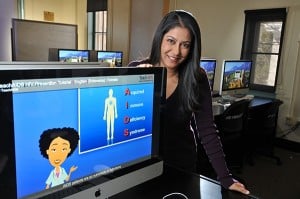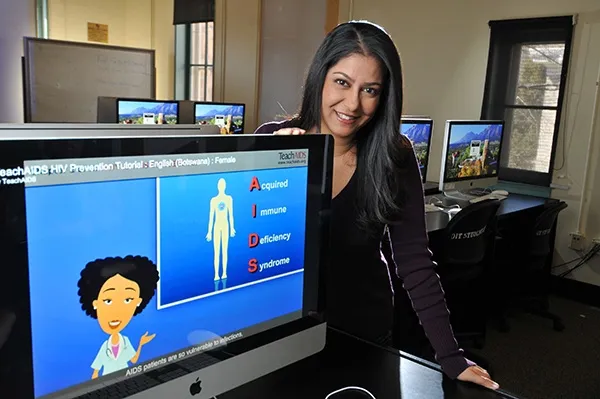TeachAIDS, founded by a Stanford alumnus, aims to educate the world about AIDS prevention.
“They say when you find work that you love, you never work a day in your life. That’s what it’s like for me.”
When founder and CEO of TeachAIDS, Piya Sorcar M.A. ’06 Ph.D. ’09, describes her job, the passion in her voice is unmistakable.
Started in 2005, TeachAIDS is a nonprofit organization that grew from Sorcar’s graduate research here at Stanford. Having earned her master’s degree in Learning, Design and Technology and her Ph.D. in the fields of Learning Science and Technology Design and International Comparative Education, she used her interdisciplinary background to solve a problem from her native country, India: HIV/AIDS education and prevention.
“Millions of dollars were poured into efforts [in India], but…

it turned out that sex education was banned in some states, and even in states where it was not explicitly banned, educators were afraid to teach it,” Sorcar said. “We wanted to look at ways to teach AIDS education without covering [such] taboo topics of death and sex.”
When Sorcar began posting her work online, she received a huge response from the global community saying that AIDS education was a problem everywhere. As a result, TeachAIDS started to develop materials for countries other than India.
“The idea was to create the best, most comprehensive AIDS education while bypassing those problems [of social stigmas] and making the teaching software available for free,” she said. “We work with governments to get it into the school systems, NGOs and corporations. And [these groups] don’t have to get [government] permission to use them. They’re available under a creative common license.”
After Sorcar finished her studies at Stanford, TeachAIDS formally partnered with the University, and now the organization conducts all of its research on the Farm. Sorcar has formed a team of diverse members, some of whom are Stanford affiliates, to figure out different ways to educate individuals across the world about AIDS prevention. For example, co-founder of TeachAIDS and Stanford Communication professor Clifford Nass specializes on the psychology of how people use technology, a field of research that provided him with the tools to test how people respond to different types of AIDS education. Nass says that Sorcar employed the help of a multitude of individuals to focus on specific aspects of the project.
“I was involved in a lot of the design decisions,” said Nass. “She had separate people who specialized in the content, [and] she got people from the medical school to help with all the science and to make sure everything was accurate.”
Through easy-to-understand animations tailored to specific cultures and ethnicities, TeachAIDS focuses on AIDS prevention education. With comprehensive testing, the organization ensures that kids understand every aspect of the animated curriculum, including the characters, analogies and metaphors involved in the media.
TeachAIDS’ success stems from its animations’ unique approach toward AIDS education, namely coupling biology-based explanations with cultural euphemisms.
“Every single piece of the process is research-based,” Sorcar said. “In the pilot versions, we used voices in the right accents of people from those areas. [Nass’] research on voice interfaces shows that people learn more when they’re listening to voices that they can relate to.”
The final productions of the animations, however, use voices of celebrities local to the countries in which the videos will be shown. Recruiting these stars has been a huge accomplishment for the organization, and the software’s “2-D, Disney-style characters” often resemble the celebrities.
“When I first heard about TeachAIDS, I knew it was exactly what our country needed to fight against the tremendous HIV plague we are facing,” said “Idols East Africa” judge Thato “Scar” Matlhabaphiri. “Launching these animations and making them available for free is a huge step in increasing knowledge and curbing infection rates. I feel honored to be part of this historical moment.”
Still, despite the progress the group has made in its work promoting AIDS education, Sorcar insists that it’s no easy task.
“At the end of the day, it’s not easy to teach about this topic,” she said. “The characters have to feel like they’re from that cultural context, and the language can’t be too bookish. Even when we’re disseminating the materials, we work with all these organizations that people trust and that are already in those countries.”
Although the original target audience had been young people, the program has since expanded to include individuals of all ages and walks of life. From military doctors educating soldiers to corporations educating employees, individuals of all ages and backgrounds have watched the animations; even prisons and rehabilitation centers have used them.
“It works even in places where it isn’t taboo,” Nass said. “It’s an extremely well-designed and effective program.”
In fact, the program is so well-designed that Sorcar was recognized in 2011 by the MIT Technology Review, which gives 35 awards each year to innovators under the age of 35 for transforming technology.
The company’s next goal is to create versions of its animations in more than 80 languages; if successful, it will be able to account for the languages of individuals from more than 90 percent of the world’s HIV and AIDS cases. The company has also been asked about creating similar tutorials for topics like tuberculosis and malaria.
“When I graduated [from Stanford] in 2009, [TeachAIDS] was in five countries,” Sorcar said. “Now the materials are used in 72 countries. The growth is incredible.”
